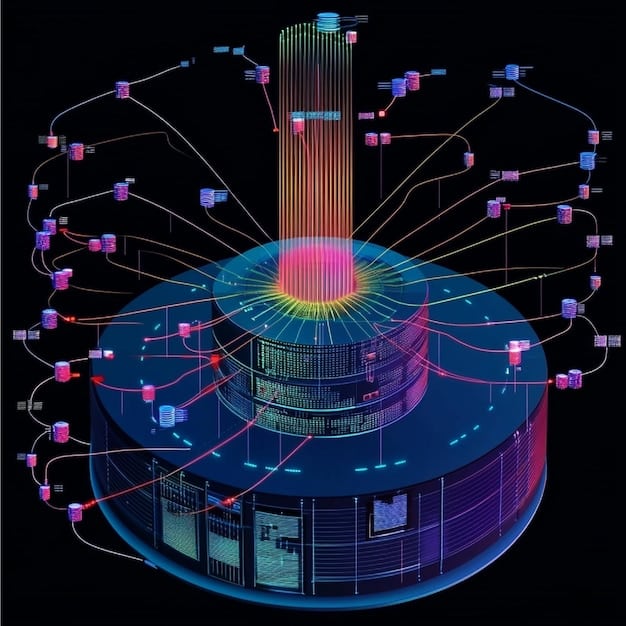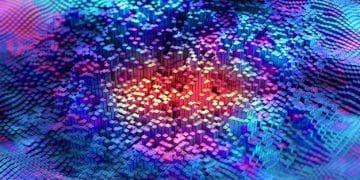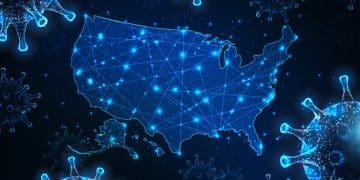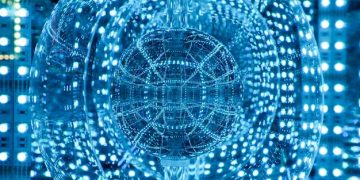Quantum Computing’s 2025 Impact on US Data Security

By 2025, quantum computing is projected to dramatically reshape US data security, presenting both unprecedented threats to current encryption standards and promising new avenues for defense against sophisticated cyberattacks, necessitating urgent strategic adaptations.
The dawn of quantum computing heralds a new era, promising computational power far beyond anything we currently possess. However, this transformative technology also casts a long shadow over existing cybersecurity paradigms. The question, How Will Quantum Computing Impact US Data Security by 2025?, is no longer speculative but critical, demanding immediate attention from government agencies, corporations, and individuals alike.
Understanding the Quantum Threat to US Data Security
By 2025, the theoretical capabilities of quantum computers will begin to manifest in tangible, albeit still nascent, systems. While fully error-corrected, large-scale quantum computers capable of breaking all modern encryption may still be a decade or more away, the inherent risks are already forcing a reevaluation of current security protocols. The immediate concern lies with algorithms like Shor’s, which can efficiently factor large numbers, a task foundational to current public-key cryptography.
The very fabric of secure communication, from financial transactions to national intelligence, relies heavily on cryptographic primitives that are vulnerable to quantum attacks. This looming threat necessitates proactive measures, especially given the “harvest now, decrypt later” strategy that some adversaries might employ. Data encrypted today could be stored and decrypted by a powerful quantum computer in the future, rendering long-term secrets exposed.
The Vulnerability of Current Cryptography
The most widely used encryption standards, such as RSA and Elliptic Curve Cryptography (ECC), depend on the computational difficulty of specific mathematical problems. Quantum computers, leveraging principles of superposition and entanglement, can solve these problems with unprecedented speed. This capability fundamentally undermines the security assumptions these systems are built upon.
- RSA: Relies on the difficulty of factoring large prime numbers. Shor’s algorithm provides an exponential speedup for this problem.
- ECC: Based on the difficulty of the elliptic curve discrete logarithm problem, also susceptible to quantum algorithms.
- Symmetric Cryptography (AES): Generally considered more resistant, but Grover’s algorithm could halve the effective key length, requiring larger key sizes for equivalent security.
The implications for US data security are profound. Critical infrastructure, government communications, military intelligence, and sensitive personal data are all protected by these vulnerable algorithms. The window of opportunity to transition to new, quantum-resistant cryptosystems is closing rapidly.
Potential Quantum Attacks by 2025
While a full-scale “quantum apocalypse” is unlikely by 2025, experimental quantum computers will likely demonstrate proof-of-concept attacks. These demonstrations could showcase the ability to break classical cryptographic challenges, serving as a stark warning and accelerating the timeline for security upgrades. Even small, noisy quantum computers, if optimized, could pose localized threats.
Moreover, the development of quantum algorithms for other cybersecurity challenges, such as optimizing malware detection or enhancing network intrusion capabilities, could also emerge. The competitive advantage of nations or entities harnessing these capabilities early could be substantial, creating a new arms race in cyberspace.
The United States government and private sector are keenly aware of these challenges. Initiatives are underway to research, develop, and eventually deploy quantum-safe cryptographic solutions. The race is on not just to build quantum computers, but to build defenses against them.
Quantum Computing’s Role in Enhancing US Data Security
Despite the formidable threats, quantum computing is not solely a harbinger of doom for data security. It also offers powerful tools and methodologies to bolster cybersecurity defenses. By 2025, initial applications of quantum technologies in defense are expected to emerge, providing a new layer of protection against evolving cyber threats. This dual nature makes quantum computing a critical area of strategic investment for the US.
Developing Post-Quantum Cryptography (PQC)
The most crucial defensive application of quantum computing research is the development of PQC. These are cryptographic algorithms designed to be resistant to attacks by both classical and quantum computers. National and international standardization bodies, such as the National Institute of Standards and Technology (NIST), are actively evaluating and standardizing these new algorithms. By 2025, some of these standards are likely to be finalized, paving the way for widespread adoption.
- Lattice-based cryptography: Utilizes complex mathematical structures that are hard for quantum computers to unravel.
- Code-based cryptography: Relies on error-correcting codes, offering robustness against quantum attacks.
- Multivariate cryptography: Based on solving systems of multivariate polynomial equations, a problem thought to be quantum-resistant.
The transition to PQC will be a monumental and complex undertaking, requiring significant investment in research, infrastructure upgrades, and personnel training. However, it is an unavoidable step to secure US data in the quantum era.
Quantum Key Distribution (QKD) and Quantum Random Number Generators (QRNG)
Beyond PQC, quantum mechanics itself offers inherently secure communication channels. Quantum Key Distribution (QKD) leverages the principles of quantum physics to establish cryptographic keys in a way that detects any eavesdropping attempt. Any measurement of a quantum state alters it, immediately notifying the communicating parties of a security breach.

By 2025, QKD might see limited deployment in highly sensitive environments, such as government communications or critical financial transfers, where the highest levels of security are paramount. Combined with Quantum Random Number Generators (QRNGs), which produce truly unpredictable random numbers essential for strong encryption, these technologies promise a new level of cryptographic security impossible with classical methods.
QRNGs utilize quantum phenomena like quantum tunneling or photon emissions to generate entropy. The true randomness ensures that keys generated are not subject to algorithmic predictability, a common vulnerability in classical pseudo-random number generators.
Quantum Computing for Threat Detection and Analysis
Quantum computers could also be employed to enhance conventional cybersecurity methods. Their ability to process vast datasets and explore complex problem spaces rapidly could revolutionize threat detection, malware analysis, and anomaly detection. By 2025, research might show early promise in areas such as:
Optimizing machine learning algorithms used in AI-driven cybersecurity systems. Quantum machine learning could identify subtle patterns indicative of sophisticated cyber threats far more effectively than classical methods. This could lead to faster and more accurate detection of zero-day exploits and advanced persistent threats.
Simulating complex network behaviors to identify vulnerabilities and predict attack vectors. Quantum simulations could model the behavior of entire networks and their potential weaknesses, allowing for proactive defense strategies. This predictive capability could provide a significant advantage in the ongoing cyber arms race.
Quantum-enhanced solutions could significantly improve the speed and efficacy of incident response, reducing the time an attacker has within a system and minimizing potential damage.
Challenges and the Road Ahead for US Data Security by 2025
The path to a quantum-resilient data security infrastructure by 2025 is fraught with challenges. Technical hurdles, economic considerations, and the need for global cooperation all contribute to the complexity of this transition. The sheer scale of updating cryptographic systems across all critical sectors in the US is immense, requiring a concerted national effort.
The Scale of Cryptographic Transition
Migrating from current cryptographic standards to post-quantum cryptography (PQC) is not merely a software update. It involves re-evaluating every piece of hardware, software, and protocol that relies on cryptography. This includes everything from secure boot processes in operating systems to secure communication channels between servers, and even smart card authentication.
The “crypto-agility” of systems, their ability to easily switch between different cryptographic algorithms, is currently limited. Many legacy systems are deeply embedded and difficult to upgrade. By 2025, organizations will be in the early stages of identifying their cryptographic inventory and developing transition roadmaps, but full implementation will extend well beyond this timeframe.
Furthermore, the interoperability of new PQC standards with existing infrastructure and international partners is a significant concern. A globally coordinated effort is essential to avoid fragmentation and maintain seamless secure communication.
Economic and Workforce Implications
The transition to quantum-safe security will require substantial financial investment. Research and development of PQC, deployment of new hardware, and retraining of IT and cybersecurity professionals will incur significant costs. Small and medium-sized enterprises (SMEs) might struggle to keep pace, creating potential vulnerabilities within the broader supply chain.
There is also a pressing need for a skilled workforce capable of understanding, implementing, and managing quantum-safe technologies. By 2025, universities and vocational programs must proactively educate a new generation of quantum-aware cybersecurity experts. Without adequate human capital, even the best technological solutions will fall short.
Investing in quantum education and workforce development is as crucial as investing in the technology itself. The US needs to ensure a pipeline of talent to support this technological shift, preventing a critical skills gap from emerging.
Key US Government Initiatives and Industry Responses
Recognizing the urgency, the US government has launched several initiatives aimed at addressing the quantum threat and advancing quantum-safe solutions. These efforts involve multiple agencies, aiming for a coordinated national strategy. The private sector, particularly large tech companies and defense contractors, is also ramping up its investments in quantum technologies.
National Quantum Initiative Act
The National Quantum Initiative (NQI) Act, signed into law in 2018, provides for a coordinated federal program to support quantum information science and technology. This act funds research across various government agencies, including the Department of Energy, NIST, and NSF, among others. By 2025, the NQI will have fostered significant breakthroughs and laid critical groundwork for quantum-safe transitions.
The NQI specifically aims to accelerate the development of quantum computing capabilities while also addressing their security implications. This dual focus ensures that while the US pursues quantum advantage, it is also preparing for the defensive requirements of a quantum-enabled world. This strategic foresight is crucial for maintaining a leading edge in technology and security.
NIST Post-Quantum Cryptography Standardization
NIST’s ongoing Post-Quantum Cryptography Standardization process is perhaps the most critical component of the US response. This multi-year effort involves soliciting, evaluating, and standardizing new cryptographic algorithms resistant to quantum attacks. By 2025, NIST is expected to have finalized initial PQC standards, which will serve as the foundation for the upcoming cryptographic migration.
The rigorous evaluation process involves cryptographers from around the world, ensuring that the selected algorithms are robust and meet the highest security requirements. These standards will provide the blueprints for developers to integrate PQC into their products and services, creating a unified and secure ecosystem.
Industry Collaboration and Corporate Adoption
Leading US technology companies are actively participating in PQC research and development, often in collaboration with government agencies and academia. Companies like IBM, Google, and Microsoft are investing heavily in quantum computing hardware and software, while also exploring post-quantum solutions. By 2025, many major tech players will have integrated PQC readiness into their product roadmaps.
Furthermore, defense contractors and financial institutions are beginning to assess their cryptographic posture and plan for the transition. The secure supply chain will inevitably need to adopt these new standards, making quantum readiness a competitive advantage and a necessity.
The synergy between government, academia, and industry is vital for a successful transition. This collaborative approach leverages diverse expertise and resources to tackle the complex challenges posed by quantum computing.
The Urgency of Quantum Readiness by 2025
The timeframe leading up to 2025 is not a period of inaction but one of critical preparation. While large-scale quantum computers capable of breaking all encryption are still some years away, the “harvest now, decrypt later” threat means that sensitive data encrypted today could be compromised in the future. This necessitates immediate action in identifying, inventorying, and planning the migration of cryptographic assets.
Identifying and Prioritizing Assets
Organizations must categorize their data based on its confidentiality requirements and expected lifetime. Data that needs to remain secret for decades, such as national security secrets, intellectual property, or long-term financial records, requires immediate attention. Identifying where current vulnerable cryptography is used across an organization’s entire digital footprint is the first crucial step.
This inventory process is often more complex than anticipated, as cryptographic implementations can be deeply embedded in various systems and applications. Without a clear understanding of what needs to be protected and how, any transition strategy will be incomplete.
By 2025, it is imperative that all critical US infrastructure sectors have completed this inventory and prioritization phase, moving into the active planning and testing of PQC solutions.
Developing Transition Roadmaps and Testing
Once assets are identified, organizations need to develop comprehensive transition roadmaps. These roadmaps will outline the phased implementation of PQC across their systems, prioritizing the most vulnerable and critical components first. This includes not only software updates but also potential hardware replacements for systems that cannot be easily patched.
Extensive testing of PQC algorithms in real-world environments is crucial to ensure their performance and compatibility. Enterprises will need to build quantum-ready testbeds to evaluate the efficacy and efficiency of new cryptographic protocols before widespread deployment. This iterative testing process will help identify and mitigate potential vulnerabilities or performance bottlenecks.
The complexity of integrating new cryptography into existing systems requires careful planning and execution. A gradual, well-tested approach will minimize disruption and maintain the integrity of secure communications during the transition.
International Cooperation and Geopolitical Landscape
Quantum computing’s impact on data security is not confined to national borders. The global nature of data flow and the interconnectedness of cyber threats necessitate international cooperation. By 2025, the geopolitical landscape surrounding quantum technology will be heavily influenced by advancements and strategic decisions made by leading nations.
Setting Global Standards
Achieving a common set of post-quantum cryptographic standards across nations is vital for global secure communication and trade. Without international alignment, data exchanges between countries could be at risk, creating cryptographic “islands” and interoperability nightmares. NIST’s standardization efforts, while US-led, are internationally recognized and involve global participants.
Collaborative efforts through organizations like the International Organization for Standardization (ISO) and the International Telecommunication Union (ITU) are essential. By working together, nations can pool resources, share expertise, and collectively defend against the quantum threat, rather than fragmenting efforts.
The US engagement with allies on quantum security initiatives will be a critical diplomatic component, ensuring a unified front in addressing this global challenge.
The Quantum Arms Race
The potential for quantum computing to break existing encryption has fueled a “quantum arms race” among major global powers. Nations are investing heavily in quantum research not only for economic and scientific benefits but also for national security. The capability to decrypt adversary communications could provide an unprecedented intelligence advantage.
By 2025, the competitive aspect will likely intensify. The US must continue to lead in quantum information science to maintain its strategic advantage and ensure its data security. Balancing open scientific collaboration with national security interests will be a delicate act in the coming years.
Understanding and anticipating the quantum capabilities of potential adversaries is a constant priority. This includes not only their progress in building quantum computers but also their strategies for exploiting quantum vulnerabilities.
Ethical Considerations and Future Projections
Beyond the immediate technical and geopolitical implications, the rise of quantum computing also brings forth profound ethical questions concerning privacy, surveillance, and the balance of power. By 2025, these discussions will become more prominent, influencing policy and public discourse.
Privacy in a Quantum World
The ability of quantum computers to decrypt vast amounts of previously secure data raises significant privacy concerns. How will personal data be protected if current encryption becomes obsolete? The development and widespread adoption of quantum-safe encryption are paramount to protecting individual privacy rights in the quantum era. Without it, the risk of mass surveillance by state actors or corporations escalates dramatically.
Furthermore, the ethical implications of quantum machine learning in areas like facial recognition or predictive policing need careful consideration. The enhanced computational power could lead to more invasive surveillance capabilities, prompting debates on balancing security with civil liberties.
By 2025, discussions around quantum ethics will highlight the need for robust legal frameworks and international agreements to govern the use of quantum technologies, ensuring they serve humanity’s best interests rather than undermining fundamental rights.
Long-Term Data Security Prospects
Looking beyond 2025, the evolution of quantum computing suggests a future where data security will be a perpetually dynamic field. As quantum computers become more powerful, new quantum-resistant algorithms may need to be developed and deployed. This continuous innovation will require ongoing investment in research and a flexible, adaptable security infrastructure.
The concept of “quantum advantage” in cybersecurity may shift from merely breaking classical encryption to developing entirely new ways of securing data through quantum principles. This could include quantum internet protocols that are intrinsically secure or quantum sensors that enhance physical security.
Ultimately, by 2025, countries, specially US, will not only be preparing for the onslaught of quantum threats but also beginning to harness quantum capabilities for creating a more secure digital future. The journey is complex, but the potential for both peril and progress is immense.
| Key Aspect | Brief Description |
|---|---|
| 🚨 Quantum Threat | Current encryption (RSA, ECC) vulnerable to quantum algorithms like Shor’s by 2025. |
| 🛡️ Post-Quantum Crypto | NIST’s PQC standardization crucial for quantum-resistant algorithms deployment. |
| ⚙️ Transition Challenges | Massive effort needed to upgrade infrastructure and retrain workforce. |
| 🌐 Global Cooperation | International standards and collaboration are essential for collective defense. |

Frequently Asked Questions About Quantum Computing and US Data Security
While experimental quantum computers will advance markedly, it’s highly unlikely they will break all existing encryption by 2025. The threat mainly pertains to public-key cryptography (RSA, ECC), with symmetric encryption (AES) requiring larger key sizes to remain secure against quantum attacks.
Post-quantum cryptography refers to algorithms designed to be secure against attacks by both classical and quantum computers. Organizations like NIST are actively standardizing these new cryptographic methods to prepare for the quantum era and protect sensitive data.
The US government, through initiatives like the National Quantum Initiative Act and NIST’s PQC standardization process, is funding research, developing new algorithms, and preparing for a national migration to quantum-resistant encryption across critical sectors.
Yes, beyond posing threats, quantum computing offers solutions. Quantum Key Distribution (QKD) provides intrinsically secure key exchanges, while Quantum Random Number Generators (QRNGs) enhance encryption. Quantum machine learning also holds promise for advanced threat detection and analysis, bolstering defenses.
This strategy involves adversaries collecting and storing encrypted data today, anticipating that future, powerful quantum computers will be able to decrypt it. This means long-term sensitive information could be compromised years after its initial transmission, highlighting the urgency for quantum-safe solutions.
Conclusion
The period leading up to 2025 is a pivotal juncture for US data security in the face of quantum computing. While fully capable quantum computers may not be ubiquitous, the theoretical groundwork for quantum-based attacks is firmly established, and early-stage machines could demonstrate significant capabilities. The “harvest now, decrypt later” threat is a tangible and immediate concern, compelling government agencies and private industries to accelerate their transition to post-quantum cryptography (PQC). The challenges are immense, encompassing the vast scale of cryptographic migration, significant economic investments, and the critical need for a new generation of skilled cybersecurity professionals. Yet, the quantum landscape also offers unprecedented opportunities to fortify defenses through PQC, Quantum Key Distribution, and advanced threat detection. By proactively engaging in research, standardization, and national and international cooperation, the US aims not merely to defend against quantum threats but to harness quantum technology to secure its digital future. The journey is complex, but the strategic imperative to achieve quantum readiness by 2025 is clear, shaping a new era of cybersecurity.





